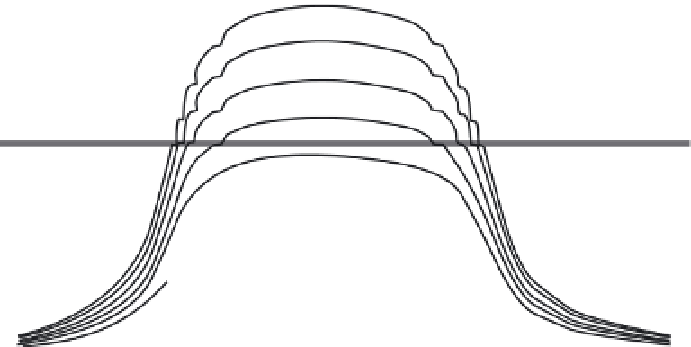Geology Reference
In-Depth Information
Box 9.1
Marine terraces on a growing fold.
In addition to the effects of differential warping or fault offsets on terrace patterns, one can
wonder how a changing sea level would interact with a three-dimensional deforming shape,
such as a growing fold that is increasing in amplitude through time. Some simple models of a
growing anticline (Ward and Valensise, 1994) predict patterns of strand lines that are not
intuitively obvious. In the model (see figure), a fold grows above a buried thrust fault in such
a manner that the crest of the fold is uplifted at a steady rate through time. Every 100 kyr a new
terrace is cut into the margins of the fold during a highstand, referred to here as a reference
sea level. Thus, one might expect that, given a uniformly growing fold and terrace-cutting
episodes regularly spaced in time, the terraces would show a uniform spatial distribution. Such
spacing is not borne out in the model, however, because the emergent part of the fold becomes
broader through time.
Growing Anticline
terrace age
and altitude
100-kyr increment
of relative sea-level fall
topography through time
500 ka
uplifted
terrace
100 ka
400 ka
200 ka
300 ka
300 ka
200 ka
400 ka
100 ka
reference sea level
500 ka
100-kyr increment
of
constant
rock uplift
Model of marine terraces etched into the flanks of a growing anticline. Modified after Ward and Valensise (1994).
Although uplift is steady at any point along the fold, it decreases from the crest of the fold
toward its flanks. Therefore, younger terraces that are formed on the ever-widening fold as it
emerges above sea level are spaced more closely than older terraces formed when the emergent
fold was narrower. Whereas the changing vertical spacing of the terraces, such as those depicted
here, would often be interpreted as indicating a steady deceleration in the rate of uplift, the
variable spacing is in fact a simple consequence of the shape of the steadily growing fold. This
model would predict a uniform vertical spacing of terraces only in situations where the coastal
region is experiencing a block-like uplift. Thus, in analyzing any coastal terrace sequence, the
cause of the oceanward slope of the land surface should be considered. Is it a result of folding
such that interior regions have been uplifted more rapidly than the coastal area? Or is it a
geomorphic surface created in the absence of differential tilting? Given the model predictions
described here, the distinction between a tectonically created slope and a geomorphic slope is
fundamental to making a reliable interpretation of a terrace succession.


























































































